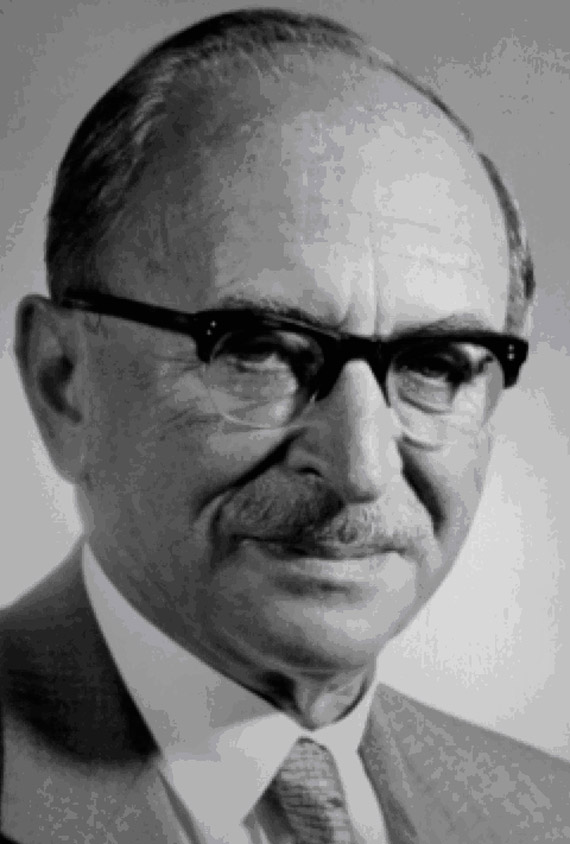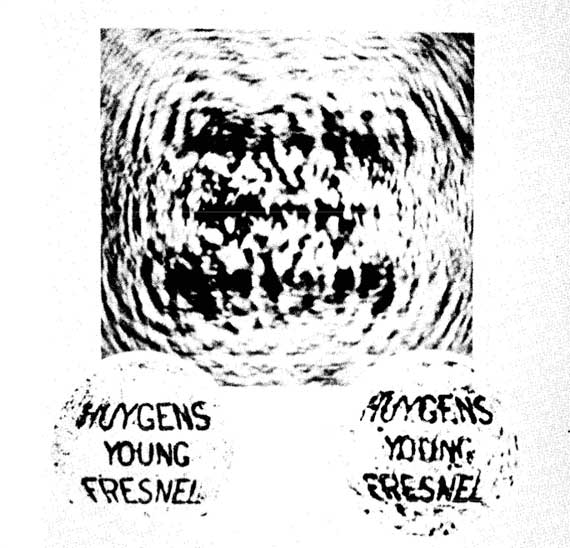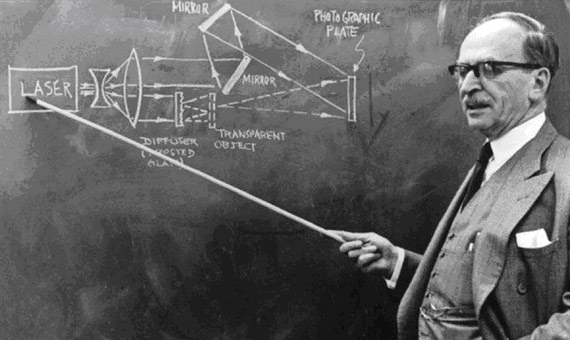Dennis Gabor (5 June 1900 – 9 February 1979) was born in Budapest, Hungary, a country that was then part of the Austro-Hungarian Dual Monarchy. Although physics fascinated him, he finally decided to study engineering. Later he wrote: «Physics was not yet a profession in Hungary, with a total of half-a-dozen university chairs – and who could have been presumptuous enough to aspire to one of these?» When Gabor was 18 he was sent to northern Italy to serve with the Hungarian artillery in the last months of the First World War. When the war ended in late 1918, he began studies in electrical engineering in Budapest which he finished at the Technical Hochschule Berlin-Charlottenburg, where he obtained a Diploma in Electrical Engineering in 1924. He also attained the degree of Doctor of Engineering (Dr-Ing.) in 1927 with a thesis related to the development of one of the first high speed cathode ray oscillographs.

That year he also joined Siemens & Halske AG, Berlin, where he started working in one of the physical laboratories, in which Gabor began to develop some of his numerous inventions. As proof of his fruitful work as an inventor, Gabor filed 62 patents between 1928 and 1971. In 1933, a few weeks after Hitler came to power, Gabor left Germany because the company did not renew his contract due to his Jewish origin. In 1934, and after a short period in Hungary, he went to England, where he got a job with the British Thomson-Houston Company in Rugby.
Throughout his entire life Gabor always said he was an engineer and inventor rather than a scientist, even though his work was almost always related to applied physics. But Gabor was also a humanist in the sense of the Renaissance: voracious reader, writer, essayist, man concerned about the technological society of the late twentieth century and member of the Club of Rome. Since 1958 he devoted much of his time to study the future of our industrial civilization on which he published, among others, the book Inventing the Future, published in 1963, and where he stated:
«You cannot predict the future, but you can create it.»
The Way to Holography
Holography begins to take its first steps in 1947 in a laboratory of an electrical engineering company where Gabor was working on improving the electron microscope. This instrument had increased one hundred times the resolving power of the best optical microscopes and it was very close to solving the atomic structures, but the system was not quite perfect. Its main limitation was related to the spherical aberration of the magnetic lenses of the microscope. To solve this problem Gabor asked himself: «Why not take a bad electron picture, but one which contains the whole information, and correct it by optical means?»
Gabor came up with the answer to this question while he was waiting for a game of tennis on Easter Day 1947 and it was to consider a two-step process. In the first stage, the recording, the interference pattern between a coherent electron beam (object wave) and a “coherent background” (reference wave) is recorded on a photographic plate. Gabor called this interference pattern “hologram”, from the Greek word “holos”, the “whole”, because it contained the whole information (amplitude and phase) of the object wave. In the second stage, the reconstruction, the hologram is illuminated with visible light and the original wavefront is reconstructed, so that the aberrations of the electron optics can be corrected by optical methods. Therefore, the physical principles of holography are based on the wave nature of light and they are interference (recording step) and diffraction (reconstruction step). He spent the rest of the year working on his ‘new microscopic principle’.
To obtain contrast interference fringes it is necessary to use a light source of high coherence, which did not exist in times of Gabor (the laser was invented in 1960). Due to this, Gabor made his first hologram in 1948 using a light source that consisted of a mercury arc lamp with a narrow-band green filter, one of the best coherent light sources before the laser. The object was a tiny circular transparency (1.4 mm diameter) of opaque lettering on a clear background containing the names of Huygens, Young and Fresnel, three physicists who were considered important by Gabor because they developed the physical basis of his technique, which he called “wave-front reconstruction”.

In 1948 Gabor published a short paper in Nature entitled A New Microscopic Principle and the same year a Gabor’s 33-page paper (Microscopy by Reconstructed Wave-Fronts) was presented to the Royal Society of London by Lawrence Bragg on Gabor’s behalf. In this paper, which was published the next year in the Proceedings of the Royal Society of London A, Gabor stated: «The name ‘hologram’ is not unjustified, as the photograph contains the total information required for reconstruction the object, which can be two-dimensional or three-dimensional.» In the abstract of this paper Gabor clearly outlines, in a simple way, what is and how works holography:
«The subject of this paper is a new two-step method of optical imagery. In a first step the object is illuminated with a coherent monochromatic wave, and the diffraction pattern resulting from the interference of the coherent secondary wave issuing from the object with the strong, coherent background is recorded on a photographic plate. If the photographic plate, suitably processed, is replaced in the original position and illuminated with the coherent background alone, an image of the object will appear behind it, in the original position.»
In September 15th, 1948 the New York Times carried the first-ever news story introducing the hologram: «New Microscope Limns Molecula; Britons Impressed by Paper Combining Optical Principle With Electron Method.» The “wave-front reconstruction” was well received among scientists as Lawrence Bragg and Max Born, both Nobel laureates in physics, and Charles Darwin, grandson of the evolutionist and Director of the National Physical Laboratory, and this was a key factor in improving Gabor’s career. In 1949, Gabor was appointed to take up the newly created Mullard Readership in Electronics at the Imperial College of London, and he became the director of a new Electronics laboratory.
During the following years, the wave-reconstruction technique was studied by Gordon Rogers in England, Adolf Lohmann in Germany and at Stanford University by Paul Kirkpatrick, Albert Baez (father of the singers Joan Baez and Mimi Fariña) and Hussein El-Sum. The latter held the first doctoral thesis on holography in 1952 and about fifty articles on Gabor’s technique were published during the period between 1948 and 1955. However, only small and blurry images were obtained so that by the year 1954 Gabor was frustrated to the point of desperation, trying unsuccessfully to convince his colleagues to continue with their investigations. But they lost interest in the technique due to two major reasons. The first, the inability to obtain optimum results when the method was applied to the electron microscope, and the second, because the reconstruction step of the hologram was imperfect. Gabor’s method produces an in-line hologram whose quality is poor due to the overlap of the virtual image and the real image or conjugate. When the hologram was reconstructed, a virtual image appeared in the position of the original object but, unfortunately, the view of the image was marred by the presence of a spurious real image in line with it. In 1955, after investigating various optical set-ups to minimize the effect of the conjugate image, Gabor abandoned his research about holography.
Gordon Rogers, perhaps the most enthusiastic researcher in holography, wrote in 1956: «As far I am concerned, I am quite happy to let Diffraction Microscopy die a natural death. I see relatively little future for it, and am looking forward to doing something else.» Gabor himself thought holography was no longer important that when he was appointed to a Chair of Applied Electron Physics at the Imperial College in 1958, he barely mentioned his work on ‘microscopy by wavefront reconstruction’.
A holographic explosion was originated in the United States in the 1960s after the invention of the laser in 1960 and thanks to the contributions made by Emmett Leith –who made the first hologram of a three dimensional object in 1964– and other researchers from the Willow Run Laboratories, Ann Arbor, at the University of Michigan. This holographic explosion rehabilitated the figure of Gabor, who went from being virtually unknown in 1962, to win the Nobel Prize in Physics in 1971 «for his invention and development of the holographic method.»

The laser, one of the most important and versatile scientific instruments of all time, and the off-axis holography technique developed by Leith and Upatnieks in Willow Run not only opened the world of holography to the real world of three-dimensional objects, but also they resulted in a great number of scientific and technological applications in different areas.
In his Nobel Lecture, Holography, 1948-1971, Gabor stated: «Holography is based on the wave nature of light, and this was demonstrated convincingly for the first time in 1801 by Thomas Young, by a wonderfully simple experiment.» He also considered the invention of holography and he reviewed the achievements of some holographic scientists. Gabor finished his Nobel Lecture recognizing that the contributions of other researchers helped him to win the Nobel Prize: «Summing up, I am one of the few lucky physicists who could see an idea of theirs grow into a sizeable chapter of physics. I am deeply aware that this has been achieved by an army of young, talented and enthusiastic researchers, of whom I could mention only a few by name. I want to express my heartfelt thanks to them, for having helped me by their work to this greatest of scientific honours.»
BIBLIOGRAPHY
Dennis Gabor, “Autobiography” (http://www.nobelprize.org).
Dennis Gabor, “Holography, 1948-1971”. Nobel Lecture, 1971 (http://www.nobelprize.org).
Sean F. Jonhston, “A Historian’s View of Holography”
Graham Saxby, Practical Holography (IOP Publishing Ltd. Bristol, 2004).
Augusto Beléndez
Comments on this publication